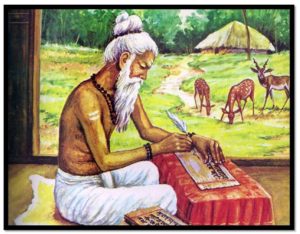After those first fortunate circumstances, on my travels to London, Delhi, and Bombay I bought several editions of the Ramayana and Maha-bharata, and immersed myself in their study. I have read these books a considerable number of times. This has given me a good grasp of their narrative structure and also of the deep philosophical and spiritual meanings that those two poems are immensely rich in. I admit that I have read the Maha-bharata some more times than the Ramayana, but I am sincere when I say that the latter has a special place in my story-loving soul.
Historical Notes
Far older than the Maha-bharata, the Ramayana was written many years ago by a respected and revered sage: Valmiki Muni. Valmiki was not always what in his days was considered an Aryan – or a man respected for his spiritual stature. On the contrary, he was a man of poor moral principles. But, through the intercession of some saints he had the good fortune to meet, Valmiki changed his mentality so profoundly that he became one of the most respected sages of his time. “Power of the pure devotees,” the poet himself would say.
The Ramayana is a very ancient story, perhaps the oldest that the world can remember. How old? There are different dates that vary considerably depending on the opinion of the scholar, but the most reliable estimates trace the first manuscript, the original one, to well before Western history recorded the first civilizations. In the times that scholars call prehistoric, India was the largest and most advanced civilization that ever existed.
Valmiki wrote his poem almost entirely simultaneously with the unfolding of the story itself, and then made it public thanks to his disciples, who went to recite it everywhere, singing and accompanying themselves with musical instruments.
This is a section of the book “The Ramayana”, in English.
To buy the complete book, click here
Post view 78 times




Leave a Reply